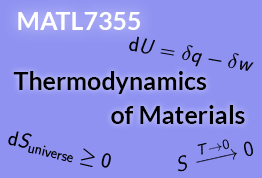Primary Textbook
No textbook will be explicitly required. However, a large portion of the course will follow the textbook by Gaskell and Laughlin:
D. R. Gaskell and D. E. Laughlin, “Introduction to the Thermodynamics of Materials“, Sixth Edition, Taylor & Francis, Washington, DC, 2018.
Secondary Literature
There are a few other textbooks that can be of interest (and the last three are available on Amazon for about $10 each):
Boris S. Bokstein, Mikhail I. Mendelev, David J. Srolovitz, “Thermodynamics and Kinetics in Materials Science”, Oxford University Press, 2005.
Svein Stølen and Tor Grande, “Chemical Thermodynamics of Materials: Macroscopic and Microscopic Aspects”, Wiley, 1st Edition, 2004.
H. C. Van Ness, “Understanding Thermodynamics”, Dover Publications Inc., 1983.
Don S. Lemons, “Thermodynamic Weirdness”, The MIT Press, 2020.
Enrico Fermi, “Thermodynamics”, Dead Authors Society, 2020.
Learning Outcomes
This course will give students the opportunity to…
- understand the basics of thermodynamics including the 3 laws of thermodynamics and extensive/intensive properties.
- become proficient in applying the laws of thermodynamic on various processes (e.g. isothermal, isobaric,…).
- understand the concepts entropy, thermodynamic potentials (such as enthalpy and Gibbs free energy), work, heat, etc.
- learn the difference between exact and inexact differentials and the difference between path and state functions.
- master thermochemistry calculations and understand temperature dependence of heat capacity and enthalpy.
- learn the basics of statistical thermodynamics and what micro/macrostates are.
- become comfortable with implementing Maxwell’s relations.
- understand and learn to read single component and binary (and ternary) phase diagrams.
- understand ideal and non-ideal gas behavior.
- learn the basics of solution thermodynamics (Henry and Raoult’s laws and Hume-Rothery rules).

